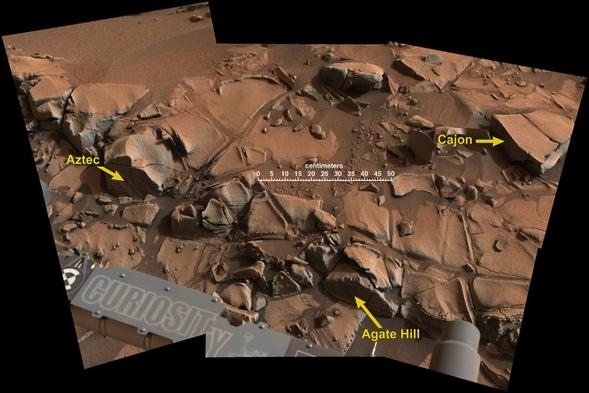Aztecs in Space (Literally)
Why did NASA scientists name a geologic feature on Mars

The Curious Aztec takes you behind the scenes of scientific investigation and discovery taking place at San Diego State University. It's pure serendipity that this week's story features the Curiosity rover and an object named "Aztec."
Last week, NASA mission controllers for the Mars rover Curiosity spied a piece of rock outcropping with tiny holes, veins and fractures in the rocks. It’s common practice for the science team to assign names to these targets to make communication easier among team members. This particular outcropping’s name? Aztec.
Intrigued, I asked Aztec alum Jordan Evans, a former member of San Diego State’s Rocket Project and an engineer at NASA Jet Propulsion Laboratory, to break down for me how these things get named (and whether he had a hand in the decision).
Martian monikers
“The naming of features and targets on Mars is a tricky business, and we have to be careful about claiming to steer it,” Evans told me. “Officially, features above a certain size like craters, chasms, hills, and plains are named by the International Astronomical Union’s Working Group for Planetary Nomenclature.* But while we’re exploring Mars on a daily basis, we need to have the ability to name large features and individual science targets so we can communicate with each other and hand off the information from one shift to the next.”
These names must be easily pronounceable and have common spellings. They typically also follow established themes for the mission. In the case of this particular mission, Curiosity was exploring Mars’ Gale Crater, which had been divided up into four quadrangles, each named for a noteworthy sedimentary outcropping on Earth.
Aztec was spotted in the Shoshone Quadrangle, which features geologic features similar to Death Valley, California. And in Death Valley, there is a particular sedimentary formation known as the Aztec Sandstone formation. Voila.
So it turns out there was no special cajoling by Evans to name the outcropping after his alma mater. Just the same, Evans told me he was quite pleased with the naming.
Two Aztecs in one
And what became of Aztec? Curiosity’s one-gigawatt ChemCam laser blasted tiny holes into the rocks and analyzed the plasma generated as a result. By analyzing the light waves emitted by this plasma, NASA scientists determined Aztec began its geologic life as a high-iron, fine-grained sandstone.
“The presence of the small holes, veins, and fractures highlight that more aqueous activity occurred on the rock after its formation and actually changed the chemical composition of the rock,” Evans explained. “We see yet another example of the long-term presence of water on Mars.”
Curiously, this is the second target to be named Aztec on the Red Planet. Earlier in the Curiosity mission, a similarly sandstone-y target had also been designated Aztec. Evans said this makes it the only target name ever to be used twice during this mission—and it’s very possible this is the only time in NASA’s history that has happened.
*This has to be in the running for the geekiest—in a good way!—organizational name ever.



